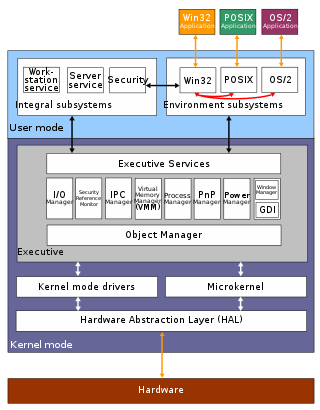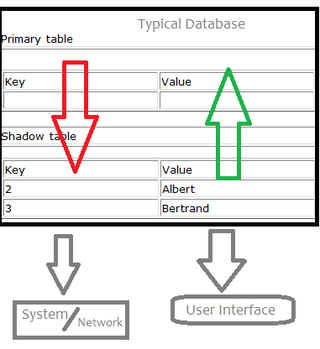Related Research Articles

In computing, a database is an organized collection of data or a type of data store based on the use of a database management system (DBMS), the software that interacts with end users, applications, and the database itself to capture and analyze the data. The DBMS additionally encompasses the core facilities provided to administer the database. The sum total of the database, the DBMS and the associated applications can be referred to as a database system. Often the term "database" is also used loosely to refer to any of the DBMS, the database system or an application associated with the database.

Multiple Virtual Storage, more commonly called MVS, is the most commonly used operating system on the System/370, System/390 and IBM Z IBM mainframe computers. IBM developed MVS, along with OS/VS1 and SVS, as a successor to OS/360. It is unrelated to IBM's other mainframe operating system lines, e.g., VSE, VM, TPF.
Mach is a kernel developed at Carnegie Mellon University by Richard Rashid and Avie Tevanian to support operating system research, primarily distributed and parallel computing. Mach is often considered one of the earliest examples of a microkernel. However, not all versions of Mach are microkernels. Mach's derivatives are the basis of the operating system kernel in GNU Hurd and of Apple's XNU kernel used in macOS, iOS, iPadOS, tvOS, and watchOS.

In computing, virtual memory, or virtual storage, is a memory management technique that provides an "idealized abstraction of the storage resources that are actually available on a given machine" which "creates the illusion to users of a very large (main) memory".

In computing, a process is the instance of a computer program that is being executed by one or many threads. There are many different process models, some of which are light weight, but almost all processes are rooted in an operating system (OS) process which comprises the program code, assigned system resources, physical and logical access permissions, and data structures to initiate, control and coordinate execution activity. Depending on the OS, a process may be made up of multiple threads of execution that execute instructions concurrently.
In computing, DLL Hell is a term for the complications that arise when one works with dynamic-link libraries (DLLs) used with Microsoft Windows operating systems, particularly legacy 16-bit editions, which all run in a single memory space.
In computer operating systems, memory paging is a memory management scheme by which a computer stores and retrieves data from secondary storage for use in main memory. In this scheme, the operating system retrieves data from secondary storage in same-size blocks called pages. Paging is an important part of virtual memory implementations in modern operating systems, using secondary storage to let programs exceed the size of available physical memory.
The Encrypting File System (EFS) on Microsoft Windows is a feature introduced in version 3.0 of NTFS that provides filesystem-level encryption. The technology enables files to be transparently encrypted to protect confidential data from attackers with physical access to the computer.
In computing, the term virtual directory has a couple of meanings. It may simply designate a folder which appears in a path but which is not actually a subfolder of the preceding folder in the path. However, this article will discuss the term in the context of directory services and identity management.
The MCP is the operating system of the Burroughs B5000/B5500/B5700 and the B6500 and successors, including the Unisys Clearpath/MCP systems.

In computing, a file system or filesystem is a method and data structure that the operating system uses to control how data is stored and retrieved. Without a file system, data placed in a storage medium would be one large body of data with no way to tell where one piece of data stopped and the next began, or where any piece of data was located when it was time to retrieve it. By separating the data into pieces and giving each piece a name, the data are easily isolated and identified. Taking its name from the way a paper-based data management system is named, each group of data is called a "file". The structure and logic rules used to manage the groups of data and their names is called a "file system."
Multilevel security or multiple levels of security (MLS) is the application of a computer system to process information with incompatible classifications, permit access by users with different security clearances and needs-to-know, and prevent users from obtaining access to information for which they lack authorization. There are two contexts for the use of multilevel security. One is to refer to a system that is adequate to protect itself from subversion and has robust mechanisms to separate information domains, that is, trustworthy. Another context is to refer to an application of a computer that will require the computer to be strong enough to protect itself from subversion and possess adequate mechanisms to separate information domains, that is, a system we must trust. This distinction is important because systems that need to be trusted are not necessarily trustworthy.

The Windows Registry is a hierarchical database that stores low-level settings for the Microsoft Windows operating system and for applications that opt to use the registry. The kernel, device drivers, services, Security Accounts Manager, and user interfaces can all use the registry. The registry also allows access to counters for profiling system performance.

The architecture of Windows NT, a line of operating systems produced and sold by Microsoft, is a layered design that consists of two main components, user mode and kernel mode. It is a preemptive, reentrant multitasking operating system, which has been designed to work with uniprocessor and symmetrical multiprocessor (SMP)-based computers. To process input/output (I/O) requests, it uses packet-driven I/O, which utilizes I/O request packets (IRPs) and asynchronous I/O. Starting with Windows XP, Microsoft began making 64-bit versions of Windows available; before this, there were only 32-bit versions of these operating systems.
Encryption software is software that uses cryptography to prevent unauthorized access to digital information. Cryptography is used to protect digital information on computers as well as the digital information that is sent to other computers over the Internet.
Dynamic-link library (DLL) is Microsoft's implementation of the shared library concept in the Microsoft Windows and OS/2 operating systems. These libraries usually have the file extension DLL, OCX, or DRV . The file formats for DLLs are the same as for Windows EXE files – that is, Portable Executable (PE) for 32-bit and 64-bit Windows, and New Executable (NE) for 16-bit Windows. As with EXEs, DLLs can contain code, data, and resources, in any combination.
The Network Livermore Timesharing System is an operating system that was actively developed at Lawrence Livermore Laboratory from 1979 until about 1988, though it continued to run production applications until 1995. An earlier system, the Livermore Time Sharing System had been developed over a decade earlier.

The kernel is a computer program at the core of a computer's operating system and generally has complete control over everything in the system. The kernel is also responsible for preventing and mitigating conflicts between different processes. It is the portion of the operating system code that is always resident in memory and facilitates interactions between hardware and software components. A full kernel controls all hardware resources via device drivers, arbitrates conflicts between processes concerning such resources, and optimizes the utilization of common resources e.g. CPU & cache usage, file systems, and network sockets. On most systems, the kernel is one of the first programs loaded on startup. It handles the rest of startup as well as memory, peripherals, and input/output (I/O) requests from software, translating them into data-processing instructions for the central processing unit.
Process isolation is a set of different hardware and software technologies designed to protect each process from other processes on the operating system. It does so by preventing process A from writing to process B.

Shadow tables are objects in computer science used to improve the way machines, networks and programs handle information. More specifically, a shadow table is an object that is read and written by a processor and contains data similar to its primary table, which is the table it's "shadowing". Shadow tables usually contain data that is relevant to the operation and maintenance of its primary table, but not within the subset of data required for the primary table to exist. Shadow tables are related to the data type "trails" in data storage systems. Trails are very similar to shadow tables but instead of storing identically formatted information that is different, they store a history of modifications and functions operated on a table.
References
- ↑ Romans, Robb R (2008-03-26). "Improve security with polyinstantiation: Using a Pluggable Authentication Module to protect private data". IBM DeveloperWorks.
- ↑ Coker, Russell (2007-01-04). "Polyinstantiation of directories in an SE Linux system". Sage 2006 .
- ↑ Jajodia, Sushil; Sandhu, Ravi S; Blaustein, Barbara T. (2006-02-01). "Solutions to the Polyinstantiation Problem" (PDF).
- ↑ Pfleeger, Charles P.; Pfleeger, Shari Lawrence (2003). Security in Computing . Prentice Hall Professional. ISBN 9780130355485.